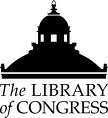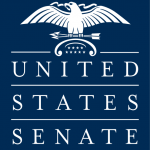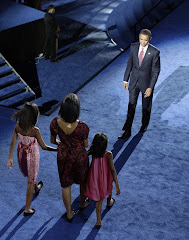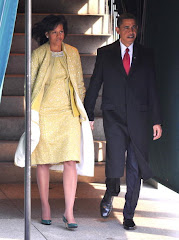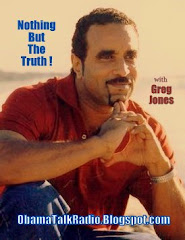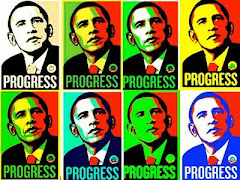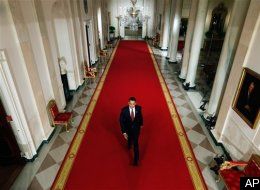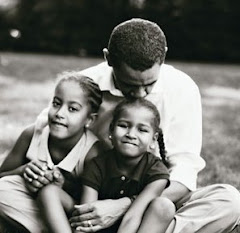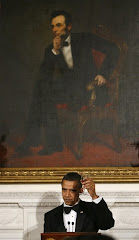The White House
Office of the Press Secretary
______________________________________________________________________________________________________________________________________________
APRIL 13, 2011
FACT SHEET: THE PRESIDENT’S FRAMEWORK FOR SHARED PROSPERITY AND SHARED FISCAL RESPONSIBILITY
The President believes that we need a comprehensive, pro-growth economic strategy that invests in winning the future, lays the foundation for strong private-sector job growth and ensures that shared prosperity will keep the American dream alive for generations to come. A key component of that strategy must be a commitment to fiscal responsibility and to living within our means. Today, the President is laying out a comprehensive, balanced deficit reduction framework to cut spending, bring down our debt and increase confidence in our nation’s fiscal strength, while supporting our economic recovery and ensuring we are making the investments we need to win the future.
· $4 Trillion in Deficit Reduction: The President is setting a goal of reducing our deficit by $4 trillion in 12 years or less. This deficit reduction would be phased in over time to protect and strengthen our economic recovery and the recovering labor market.
· Debt on a Declining Path, Backed Up By An Across the Board “Debt Failsafe” Trigger: The President’s framework would require that, by the second half of the decade, our nation’s debt is on a declining path as a share of our economy. To enforce this requirement, the President is calling on Congress to enact:
Ø A Debt Failsafe that will trigger across-the-board spending reductions (both in direct spending and spending through the tax code) if, by 2014, the projected ratio of debt-to-GDP is not stabilized and declining toward the end of the decade. Consistent with prior fiscal enforcement triggers put in place by Presidents Reagan, George H.W. Bush and Clinton, the trigger should not apply to Social Security, low-income programs, or Medicare benefits.
· Balance Between Spending Cuts and Tax Reform: The President’s framework would seek a balanced approach to bringing down our deficit, with three dollars of spending cuts and interest savings for every one dollar from tax reform that contributes to deficit reduction. This is consistent with the bipartisan Fiscal Commission’s approach.
· Shared Sacrifice from All, Including the Most Fortunate Americans: The President believes strongly that, as we make difficult choices to live within our means, we cannot afford to make our deficit problem worse by extending the Bush tax cuts for the wealthiest Americans.
· Bipartisan, Bicameral Negotiations on a Legislative Framework: The President has asked Majority Leader Reid, Speaker Boehner, Minority Leader Pelosi and Minority Leader McConnell to each designate four Members from their caucuses to participate in bipartisan, bicameral negotiations led by the Vice President, beginning in early May. The goal of these negotiations is to agree on a legislative framework for comprehensive deficit reduction.
· Policy Highlights. The policy highlights in the President’s framework build on the down-payment included in his FY 2012 Budget. They include:
Ø Non-security discretionary spending: The President is proposing to build on the savings from the FY 2011 budget agreement, while investing in key drivers of economic growth like energy innovation, education, and infrastructure. This would entail cutting non-security discretionary spending to levels consistent with the Fiscal Commission, saving $770 billion by 2023.
Ø Security spending: The President’s framework will go beyond the Fiscal Year 2012 Budget to achieve deeper reductions in security spending. It sets a goal of holding the growth in base security spending below inflation, while ensuring our capacity to meet our national security responsibilities, which would save $400 billion by 2023.
Ø Health care: The President’s framework builds on the Affordable Care Act by including new reforms aimed at further reducing the growth of health care spending – a major driver of long-term deficits. The President opposes any plan that would simply shift costs to seniors and the vulnerable by undermining Medicare and Medicaid. Building on the foundation of the historic deficit reduction achieved through the Affordable Care Act, the framework would save an additional $340 billion by 2021, $480 billion by 2023, and at least an additional $1 trillion in the subsequent decade. These savings complement the new patient safety initiative that could lower Medicare costs by another $50 billion over the next decade by providing better care. The President’s framework includes initiatives that will:
o Bend the long-term cost curve by setting a more ambitious target of holding Medicare cost growth per beneficiary to GDP per capita plus 0.5 percent beginning in 2018, through strengthening the Independent Payment Advisory Board (IPAB).
o Make Medicaid more flexible, efficient and accountable without resorting to block granting the program, ending our partnership with States or reducing health care coverage for seniors in nursing homes, the most economically vulnerable and people with disabilities. Combined Medicaid savings of at least $100 billion over 10 years.
o Reduce Medicare’s excessive spending on prescription drugs and lower drug premiums for beneficiaries without shifting costs to seniors or privatizing Medicare. Combined Medicare savings of at least $200 billion over 10 years.
Ø Other mandatory spending: Outside of health care, comprehensive deficit reduction must include savings in other mandatory programs, including agricultural subsidies, the federal pension insurance system, and anti-fraud measures, while protecting and strengthening programs that serve low-income families and other vulnerable Americans. The President’s framework includes a target of $360 billion in savings from other mandatory programs by 2023.
Ø Tax reform: the President is calling for individual tax reform that closes loopholes and produces a system which is simpler, fairer and not rigged in favor of those who can afford lawyers and accountants to game it. The President supports the Fiscal Commission’s goal of reducing tax expenditures enough to both lower rates and lower the deficit.
Ø Social Security: The President does not believe that Social Security is in crisis nor is a driver of our near-term deficit problems. But, in the context of an aging population and a Social Security wage base that is declining as a share of overall earnings, Social Security faces long-term challenges that are better addressed sooner than later to ensure that the program remains for future generations the rock-solid benefit for older Americans that it has been for past generations. That is why the President supports bipartisan efforts to strengthen Social Security for the long haul. These efforts should be guided by several principles, including strengthening the program and not privatizing it, improving retirement security for the vulnerable while protecting people with disabilities and current beneficiaries, and not slashing benefits for future generations.
DETAILS OF THE PRESIDENT’S FRAMEWORK FOR
SHARED PROSPERITY AND SHARED FISCAL RESPONSIBILITY
1. A Fiscally Responsible Economic Strategy to Invest in Competitiveness and Growth
The President believes that, if we are going to promote economic recovery, invest in our long-term competitiveness and meet our values of dignity for retirees, protection for the most vulnerable and opportunity for all Americans, a comprehensive, balanced deficit reduction framework must be part of our overall economic growth strategy.
The question is not whether we need to bring down long-term deficits and debt to build economic confidence and promote investment in the United States; instead it is how to best do so consistent with a pro-growth economic strategy. The framework the President outlined today charts a course to achieve deficit reduction and support economic growth, with a balanced approach and an enforceable backstop to ensure that we achieve our economic and fiscal goals.
2. A Deficit Reduction Goal and Enforceable Debt Failsafe
The framework the President announced today offers a balanced approach to maintaining our economic recovery while living within our means. It centers on the following goal:
· Achieving $4 trillion in deficit reduction over 12 years or less. The President believes that this goal is achievable over a 12 year period, consistent with the goals of promoting economic growth that benefits the middle class and strengthening the health and economic security of our nation’s seniors, people with disabilities and most vulnerable. The Administration projects that this framework will reduce deficits as a share of our economy to about 2.5% of GDP in 2015, and put deficits on a declining path toward close to 2.0% of GDP toward the end of the decade.
· Deficit reduction should be phased in over time to ensure that fiscal policy does not undermine the momentum of our economic recovery. Our economy has created 1.8 million private sector jobs over the last 13 months and the pace of job growth has accelerated in recent months. While long-term deficit reduction is a crucial component of the President’s economic strategy, this goal cannot be used as an excuse to undermine the near-term policies and investments we need to continue our economic recovery.
· Deficit reduction efforts should be held accountable by a “Debt Failsafe” trigger: The President is confident that, with a robust economic recovery and bipartisan agreement on deficit reduction, we will put our debt as a share of the economy on a declining path by the second half of the decade. However we must provide a strong incentive for Congress to act on a deficit reduction framework and renew confidence that we will hit this goal. Therefore, the President is calling for:
Ø A debt failsafe that will ensure that our nation’s debt is on a declining path as a share of our economy. If by 2014, budget projections do not show that the debt-to-GDP ratio has stabilized and is declining in the second half of the decade, the failsafe will trigger an across the board spending reduction, including on spending through the tax code.
Ø The trigger will ensure that deficits as a share of the economy average no more than 2.8% of GDP in the second half of the decade.
Ø Consistent with prior fiscal enforcement mechanisms put in place by Presidents Reagan, George H.W. Bush and Clinton, the trigger should not apply to Social Security, low-income programs, or benefits for Medicare enrollees.
Ø The trigger should also include a mechanism to ensure that it does not exacerbate an economic downturn or interfere with our nation’s ability to respond to a national security emergency.
3. Discretionary Spending
· Non-Security Savings Equal to the Fiscal Commission’s, While Investing In Our Future:
Ø The budget agreement negotiated by the President last week represented the largest one-year reduction in discretionary spending in our history, even as it invested in areas key to our long-run economic growth and competitiveness.
Ø We should build on this year’s savings, while ensuring that we continue to make the investments we need to win the future and not threaten the economic recovery. The President believes we can do so while generating additional deficit reduction by cutting non-security spending to levels consistent with what the Fiscal Commission recommended over the next decade.
Ø This would generate an additional $200 billion in savings over 10 years beyond the $400 billion in savings from the President’s Budget. Over 12 years, it will generate a total of $770 billion in deficit reduction.
· Additional Discipline on Security Spending While Keeping America Safe:
Ø While the President will never accept cuts that compromise our ability to defend our homeland or America’s interests around the world, Secretary Gates has shown over the last two years that there is substantial waste and duplication in our security budget that we can and should eliminate—proposing savings of $400 billion in current and future defense spending.
Ø As part of a comprehensive deficit reduction framework, the President is calling for pushing harder to not only eliminate waste and improve efficiency and effectiveness, but conduct a fundamental review of America’s missions, capabilities, and our role in a changing world.
Ø The framework sets a goal of holding the growth in base security spending below inflation, while ensuring our capacity to meet our national security responsibilities, which would save $400 billion by 2023. (The President will make decisions on specific cuts after working with Secretary Gates and the Joint Chiefs on the comprehensive review.)
Ø Note: this deficit reduction is in addition to the savings generated from ramping-down overseas contingency operations.
4. Health Care
· Medicare and Medicaid Savings of $480 Billion by 2023 and At Least an Additional $1 Trillion over the Subsequent Decade, Providing Better Care at Lower Costs:
Ø Building on the Affordable Care Act, the President is proposing additional reforms to Medicare and Medicaid designed to strengthen these critical programs by reducing waste, increasing accountability, promoting efficiency, and improving the quality of care, without shifting the cost of care to our seniors or people with disabilities.
Ø The framework will save $340 billion over ten years and $480 billion by 2023 (including the proposals already included in the President’s Budget). This framework includes the same aggregate savings that House Budget Committee Chairman Paul Ryan proposed in his November 2010 plan with Alice Rivlin and an amount sufficient to fully pay to reform the Medicare Sustainable Growth Rate (SGR) physician payment formula while still reducing the deficit.
Ø Over the subsequent decade, the President’s proposal will save well over $1 trillion by further bending the cost curve, doubling the savings from the Affordable Care Act.
Ø The President’s framework offers a stark contrast with the House Republican plan that would increase seniors’ health costs by $6,400 annually starting in 2022, raise health insurance premiums for middle-class Americans and small businesses, cut Federal Medicaid spending by one-third by the end of the decade, and increase the number of uninsured by 50 million.
· The President’s framework proposes specific reforms to strengthen Medicare and Medicaid over the long term, including:
Ø Addressing the long-term drivers of Medicare cost growth: The President’s framework would strengthen the Independent Payment Advisory Board (IPAB) created by the Affordable Care Act. The IPAB has been highlighted by economists and health policy experts as a critical contributor to Medicare’s solvency and sound operations. Under the Affordable Care Act, IPAB analyzes the drivers of excessive and unnecessary Medicare cost growth. When Medicare growth per beneficiary exceeds growth in nominal GDP per capita plus 1 percent, IPAB recommends to Congress policies to reduce the rate of growth to meet that target, while not harming beneficiaries’ access to needed services. Congress must consider IPAB’s recommendations or, if it disagrees, enact policies that achieve equivalent savings. If neither acts, then the Secretary of Health and Human Services would have to develop and implement a proposal to achieve the savings target.
The President’s framework will strengthen IPAB to act as a backstop to the other Medicare reforms by ensuring that Medicare spending growth does not outpace our ability to pay for it over the long run, while improving the program and keeping Medicare beneficiaries’ premium growth under control. Specifically, it would:
o Set a new target of Medicare growth per beneficiary growing with GDP per capita plus 0.5 percent. This is consistent both with the reductions in projected Medicare spending since the Affordable Care Act was passed and the additional reforms the President is proposing.
o Give IPAB additional tools to improve the quality of care while reducing costs, including allowing it to promote value-based benefit designs that promote proven services like prevention without shifting costs to seniors.
o Give IPAB additional enforcement mechanisms such as an automatic sequester as a backstop for IPAB, Congress, and the Secretary of Health and Human Services.
Ø Reforming the Federal-State partnerships to strengthen Medicaid and promote simplicity, efficiency, and accountability: Under current law, States face a patchwork of different Federal payment contributions for Medicaid and the Children’s Health Insurance Program (CHIP). The President’s framework would replace the current complicated Federal matching formulas with a single matching rate for all program spending that rewards States for efficiency and automatically increases if a recession forces enrollment and State costs to rise.
In addition, the President has called on the National Governors Association (NGA) to make recommendations for ways to reform and strengthen Medicaid, and the framework will consider the ideas that its Task Force produces. The President also supports reform of Medicaid to incentivize more efficient, higher quality, care for high-cost beneficiaries, including those who are eligible for both Medicaid and Medicare. These nine million beneficiaries comprise 15 percent of Medicaid enrollment but consume nearly 40 percent of total Medicaid spending.
Ø Improving patient safety: Together with employers, States, hospitals, physicians and nurses, the Administration has launched a new public-private partnership called Partnership for Patients that will help improve the quality, safety and affordability of health care for all Americans. The two goals of this new Partnership are: preventing patients from getting injured or sicker while they are in the hospital and helping patients heal without complication. Achieving the initiative’s goal would mean more than 1.6 million patients will recover from illness without a preventable complication, reducing costs by up to $50 billion in Medicare and billions more in Medicaid over the next 10 years.
Ø Cutting unnecessary prescription drug spending: The framework would limit excessive payments for prescription drugs by leveraging Medicare’s purchasing power – similar to what was called for by the bipartisan Fiscal Commission. It would speed up the availability of generic biologics, and prohibit brand-name companies from entering into “pay for delay” agreements with generic companies. And, it would implement Medicaid management of high prescribers and users of prescription drugs.
Ø Reducing abuse and increasing accountability in Medicaid and Medicare: The framework would clamp down on States’ use of provider taxes to lower their own spending while not providing additional health services through Medicaid; recover erroneous payments from Medicare Advantage; establish upper limits on Medicaid payments for durable medical equipment; and take other actions to improve program integrity.
· A major contrast with the House Republican approach. The President’s framework rejects plans that would end Medicare as we know it or transform Medicaid into a dramatically underfunded block grant, putting at serious risk not only seniors but also the most vulnerable children and people with disabilities. Some of the major problems with the House Republican approach include:
Ø The House Republican plan does nothing to reduce health costs. Instead it actually increases costs by doing nothing to reform the way health care is delivered in addition to putting a larger fraction of the burden on beneficiaries and States.
o In the first year the Republican plan goes into effect, a typical 65-year-old who becomes eligible for Medicare would pay an extra $6,400 for health care, more than doubling what he or she would pay if the plan were not adopted.
o States would get one-third less for Medicaid by 2021, potentially leaving 15 million people without coverage, including seniors in nursing homes, people with disabilities, children and pregnant women.
Ø The House Republican plan would no longer guarantee the same level of benefits and choices that seniors have today in Medicare, because the proposal allows private health plans to determine benefits, raise cost sharing, and limit choice of doctors and hospitals.
5. Other Mandatory Spending
· Outside of health care, comprehensive deficit reduction must include savings in other mandatory programs.
· The President’s Budget includes measures to reform agricultural subsidies, shore up the federal pension insurance system, restore solvency to the federal unemployment insurance trust fund, and enact anti-fraud measures.
· Building on these efforts, the President’s framework includes a target of $360 billion in savings from other mandatory programs by 2023.
· The Fiscal Commission and other bipartisan efforts have put forward additional proposals that should be considered as part of a comprehensive deficit reduction effort to meet this target.
· Reforms to mandatory programs should protect and strengthen the safety net for low-income families and other vulnerable Americans.
6. Tax Reform
· The President is calling on Congress to undertake comprehensive tax reform that produces a system which is fairer, has fewer loopholes, less complexity, and is not rigged in favor of those who can afford lawyers and accountants to game it.
· He believes we cannot afford to make our deficit problem worse by extending the Bush tax cuts for the wealthiest Americans.
· He also supports efforts to build on the Fiscal Commission’s goal of reducing tax expenditures so that there is enough savings to both lower rates and lower the deficit. Reform should be designed to ask more of those who can afford it while protecting the middle class and promoting economic growth.
· In addition, as he explained in the State of the Union, the President is continuing his effort to reform our outdated corporate tax code to enhance our economic competitiveness and encourage investment in the United States. By eliminating loopholes, reducing distortions and leveling the playing field in our corporate tax code, we can use the savings to lower the corporate tax rate for the first time in 25 years without adding to the deficit.
7. Social Security
· The President does not believe that Social Security is a driver of our near-term deficit problems or is currently in crisis. But he supports bipartisan efforts to strengthen Social Security for the long haul, because its long-term challenges are better addressed sooner than later to ensure that it remains the rock-solid benefit for older Americans that it has been for past generations. The President in the State of the Union laid out his principles for Social Security reform which he believes should form the basis for bipartisan negotiations that could proceed in parallel to deficit negotiations:
Ø Strengthen retirement security for the low-income and vulnerable; maintain robust disability and survivors’ benefits.
Ø No privatization or weakening of the Social Security system; reform must strengthen Social Security and restore long-term solvency.
Ø No current beneficiary should see the basic benefit reduced; nor will we accept an approach that slashes benefits for future generations.
###
















